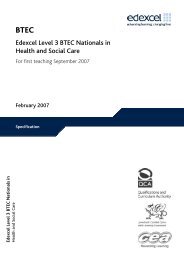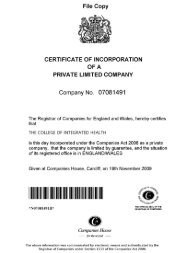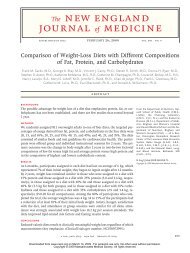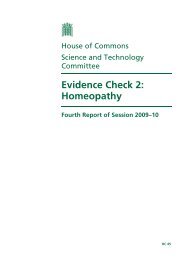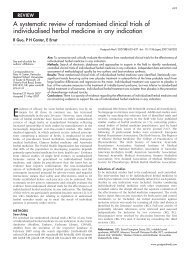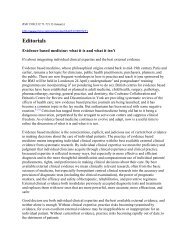German Acupuncture Trials (GERAC) for Chronic Low Back Pain
German Acupuncture Trials (GERAC) for Chronic Low Back Pain
German Acupuncture Trials (GERAC) for Chronic Low Back Pain
You also want an ePaper? Increase the reach of your titles
YUMPU automatically turns print PDFs into web optimized ePapers that Google loves.
Table 1. Eligibility Criteria<br />
Inclusion Criteria<br />
Signed written in<strong>for</strong>med consent<br />
Clinical diagnosis of chronic low back pain <strong>for</strong> 6 mo or longer<br />
CPGS grade I and HFAQ less than 70%<br />
Therapy-free interval 7dorlonger<br />
Older than 18 y<br />
Ability to speak, read, and write <strong>German</strong><br />
Exclusion criteria<br />
Treatment with needle acupuncture <strong>for</strong> low back pain at any time in<br />
the past<br />
Treatment with needle acupuncture <strong>for</strong> any other indication within<br />
the last year<br />
History of spinal fracture (eg, osteoporosis or trauma) or disc or<br />
spinal surgery<br />
Infections or tumors of the spine<br />
Systemic bone or joint disorders (eg, rheumatoid arthritis)<br />
Scoliosis or kyphosis<br />
Sciatica or chronic pain from other disease<br />
Hemorrhagic disorders or anticoagulant therapy<br />
Skin disease in the area of acupuncture<br />
Abuse of drugs or pain medication<br />
Pregnancy<br />
Epilepsy<br />
Patient included in any other studies<br />
Abbreviations: CPGS, Von Korff <strong>Chronic</strong> <strong>Pain</strong> Grade Scale; HFAQ, Hanover<br />
Functional Ability Questionnaire.<br />
tional Ability Questionnaire score of less than 70%, 8 no previous<br />
acupuncture <strong>for</strong> treatment of chronic low back pain, and<br />
signed in<strong>for</strong>med consent. Primary exclusion criteria were previous<br />
spinal surgery; previous spinal fractures, infectious, or<br />
tumorous spondylopathy; and chronic pain caused by other diseases<br />
6 (Table 1). Patients were made aware of the study through<br />
newspapers, magazines, radio, and television. A list of physicians<br />
participating in the randomized trials was available on<br />
the Internet or could be requested from the medical insurance<br />
companies or the study center. Only patients who had been<br />
therapy-free <strong>for</strong> at least 7 days were eligible <strong>for</strong> screening.<br />
Figure 1 shows participant progress through the study.<br />
<strong>Acupuncture</strong> was administered in 340 outpatient practices<br />
by physicians of various specializations who had at least 140<br />
hours of acupuncture training: 55% had undergone basic training<br />
(mean, 213 hours) and 45% had advanced training (mean,<br />
376 hours). The study physicians had practiced acupuncture<br />
<strong>for</strong> 2 to 36 years (median, 8.0 years). All took part in a 1-day<br />
training session with emphasis on acupuncture methods and<br />
study design. Each patient in the study practices was seen by<br />
the same physician-acupuncturist at each session. Independent<br />
telephone interviewers assessed outcome measures.<br />
The study was conducted in accord with International Conference<br />
on Harmonization [of Technical Requirements <strong>for</strong> the Registration<br />
of Pharmaceuticals <strong>for</strong> Human Use]–Good Clinical Practice<br />
(ICH/GCP) criteria, including independent regular monitoring<br />
and establishment of an independent data safety monitoring committee.<br />
All study participants provided written in<strong>for</strong>med consent<br />
and the study was approved by local ethics committees.<br />
INTERVENTIONS<br />
Patients were randomized to receive verum acupuncture, sham<br />
acupuncture, or guideline-based conventional therapy. All interventions<br />
comprised ten 30-minute sessions, generally 2 sessions<br />
per week, and 5 additional sessions if, after the tenth session<br />
(Figure 2), patients experienced a 10% to 50% reduction<br />
387 Allocated to verum<br />
acupuncture<br />
387 ITT<br />
370 at 6-wk Assessment<br />
17 Missed assessment<br />
373 at 3-mo Assessment<br />
14 Missed assessment<br />
377 at 6-mo Assessment<br />
10 Missed assessment<br />
1802 Participants assessed<br />
<strong>for</strong> eligibility<br />
1162 Participants were<br />
randomized<br />
387 Allocated to sham<br />
acupuncture<br />
387 ITT<br />
375 at 6-wk Assessment<br />
12 Missed assessment<br />
376 at 3-mo Assessment<br />
11 Missed assessment<br />
376 at 6-mo Assessment<br />
11 Missed assessment<br />
640 Participants were excluded<br />
342 Insufficient severity (HFAQ)<br />
233 Met exclusion criteria<br />
44 Withdrew in<strong>for</strong>med consent<br />
21 For other reasons<br />
388 Allocated to sham<br />
acupuncture<br />
1 Excluded <strong>for</strong><br />
pregnancy<br />
387 ITT<br />
361 at 6-wk Assessment<br />
26 Missed assessment<br />
361 at 3-mo Assessment<br />
26 Missed assessment<br />
364 at 6-mo Assessment<br />
25 Missed assessment<br />
Figure 1. Participant flowsheet. HFAQ indicates Hanover Functional Ability<br />
Questionnaire; ITT, intention to treat.<br />
in pain intensity (Von Korff <strong>Chronic</strong> <strong>Pain</strong> Grade Scale). 6 Interviewers<br />
and patients were blinded to this criterion. In all telephone<br />
interviews, patients were asked specifically about use<br />
of medication and physical therapy.<br />
The sterile, disposable needles (Asiamed, Pullach near Munich,<br />
<strong>German</strong>y) used <strong>for</strong> verum and sham acupuncture were<br />
identical and were either 0.25�40 mm or 0.35�50 mm. Only<br />
body needle acupuncture, without electrical stimulation or moxibustion,<br />
was allowed. Verum acupuncture consisted of needling<br />
fixed points and additional points (from a prescribed list)<br />
chosen individually on the basis of traditional Chinese medicine<br />
diagnosis, including tongue diagnosis. Fourteen to 20<br />
needles were inserted to a depth of 5 to 40 mm depending on<br />
location. Induction of de Qi (the sensation felt when an acupuncturist<br />
reaches the level of Qi [numb radiating sensation<br />
indicative of effective needling] in the body) was elicited by<br />
manual stimulation. Sham acupuncture on either side of the<br />
lateral part of the back and on the lower limbs was also standardized,<br />
avoiding all known verum points or meridians. As<br />
with verum acupuncture, 14 to 20 needles were inserted, but<br />
superficially (1-3 mm) and without stimulation.<br />
The methods of acupuncture and Chinese diagnosis were established<br />
on the basis of the international literature and a consensus<br />
process with international experts. The exact method of<br />
acupuncture has been published. 6,10 For acute episodes of pain,<br />
only rescue medication was permitted in both acupuncture<br />
groups. This was strictly defined as nonsteroidal antiinflammatory<br />
drugs to be taken on no more than 2 days per week<br />
up to the maximum daily dose during the therapy period and<br />
only 1 day per week during follow-up. Use of any additional therapies<br />
<strong>for</strong> pain during the entire study period was prohibited<br />
Patients in the conventional therapy group received a multimodal<br />
treatment program according to <strong>German</strong> guidelines. 11<br />
The guidelines provide the treating physician with recommendations<br />
about the treatment algorithm and assess the various<br />
therapy <strong>for</strong>ms according to the degree of evidence based on a<br />
literature search and recommendations of the specialist associations.<br />
Conventional therapy included 10 sessions with personal<br />
contact with a physician or physiotherapist who administered<br />
physiotherapy, exercise, and such.<br />
(REPRINTED) ARCH INTERN MED/ VOL 167 (NO. 17), SEP 24, 2007 WWW.ARCHINTERNMED.COM<br />
1893<br />
Downloaded from<br />
www.archinternmed.com at University College London, on September 25, 2007<br />
©2007 American Medical Association. All rights reserved.



